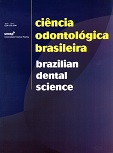Estudo da microdureza do esmalte bovino submetido ao tratamento clareador ativado por diferentes fontes de luz
DOI:
https://doi.org/10.14295/bds.2006.v9i3.239Abstract
A técnica de clareamento em consultório com peróxido de hidrogênio em forma de gel, pode ter seu tempo clínico diminuído após exposição a diferentes fontes de luz. Este trabalho avaliou a ação de diferentes fontes de luz na microdureza do esmalte dentário bovino, submetido a clareamento com peróxido de hidrogênio à 35% (Opalescence® XTRA). Foram utilizadas 20 coroas de incisivos, seccionadas em quatro fragmentos e incluídos em resina acrílica. Posteriormente, foi realizado o aplainamento da superfície. As amostras foram divididas em quatro grupos de estudo: laser de diodo (grupo A), LED (grupo B), sem ativação por luz/ controle (grupo C) e laser de Nd:YAG (grupo D). A leitura da microdureza das amostras foi realizada antes e após o tratamento clareador, obtendo-se assim a 1ª e 2ª leituras, respectivamente. Em seguida, as amostras foram armazenadas em saliva artificial por 14 dias à ±37°C, sendo tomada uma 3ª leitura da microdureza após esse período. A análise estatística ANOVA e o teste de Tukey revelaram diferença estatística entre a 1ª e 2ª leitura, nos quatro grupos estudados. Os grupos A, B e C mostraram diferença significativa entre a 1ª e 3ª leitura, com exceção do grupo D. Concluiu-se que o tratamento realizado sem ativação por luz ou com LED, levou a mesma alteração da microdureza do esmalte. O laser de diodo alterou a dureza da superfície de esmalte sem recuperação da microdureza após 14 dias. No grupo do Nd:YAG houve aumento da microdureza da superfície após o período de armazenamento.
Downloads
Downloads
Published
How to Cite
Issue
Section
License
Brazilian Dental Science uses the Creative Commons (CC-BY 4.0) license, thus preserving the integrity of articles in an open access environment. The journal allows the author to retain publishing rights without restrictions.
=================




























